

Compact Muon Solenoid
LHC, CERN
| CMS-PAS-SUS-16-045 | ||
| Search for supersymmetry with Higgs to diphoton decays using the razor variables at √s= 13 TeV | ||
| CMS Collaboration | ||
| March 2017 | ||
| Abstract: An inclusive search for anomalous Higgs boson production in the diphoton decay channel and in association with at least one jet is presented, using the LHC proton-proton collision data collected by the CMS experiment at a center-of-mass energy of 13 TeV and corresponding to an integrated luminosity of 35.9 fb−1. The razor variables MR and R2 as well as the momentum and mass resolution of the diphoton system are used to categorize events into different search regions. The search result is interpreted in the context of bottom squark pair production. Constraints are set on the production cross section as a function of the bottom squark and neutralino masses, and are translated into mass exclusion bounds. | ||
|
Links:
CDS record (PDF) ;
inSPIRE record ;
CADI line (restricted) ;
These preliminary results are superseded in this paper, PLB 779 (2018) 166. The superseded preliminary plots can be found here. |
||
| Figures & Tables | Summary | Additional Figures & Tables | References | CMS Publications |
|---|
|
Additional information on efficiencies needed for reinterpretation of these results are available here.
Additional technical material for CMS speakers can be found here. |
| Figures | |
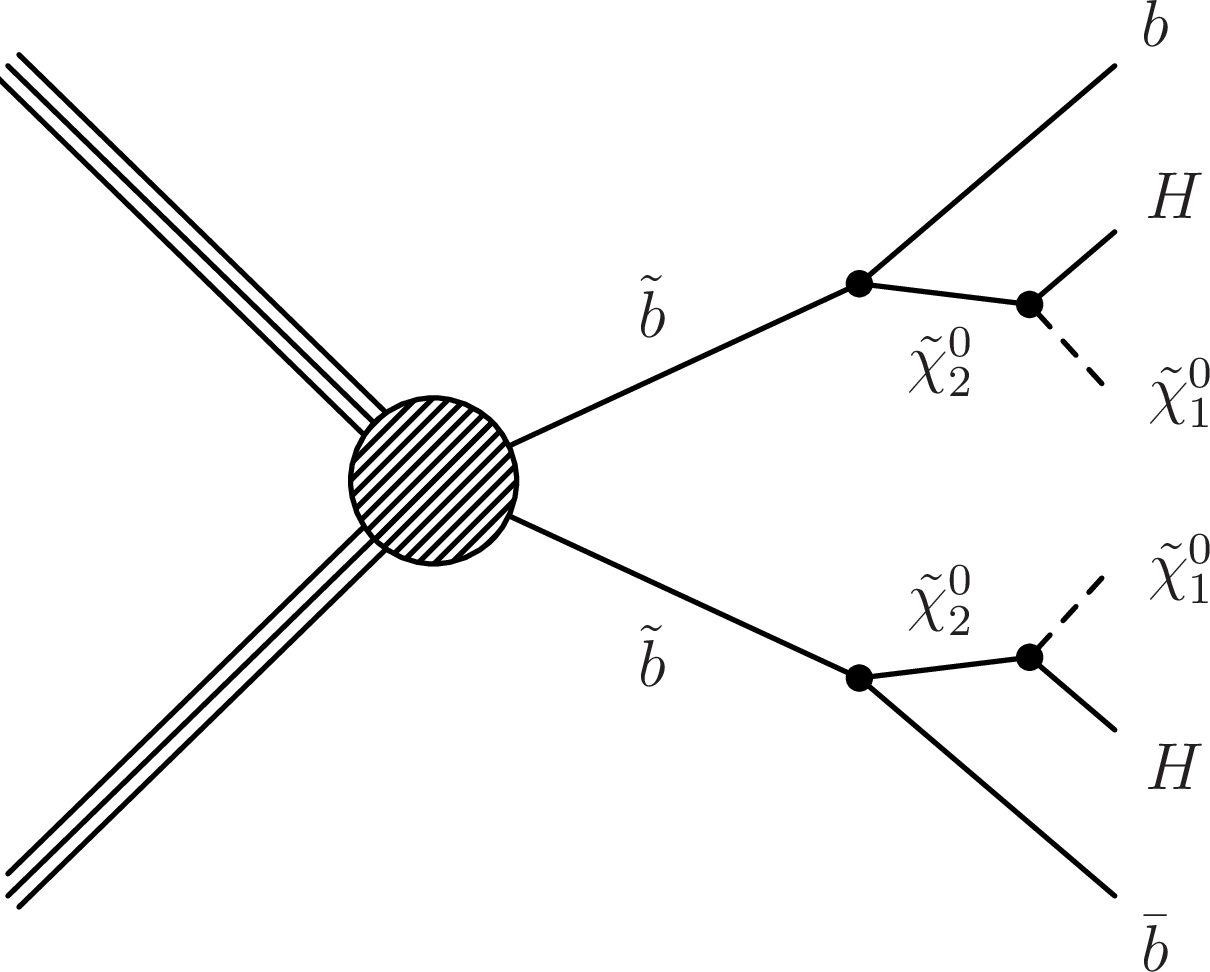
png pdf |
Figure 1:
Diagram displaying the simplified model process for bottom squark pair production leading to Higgs bosons considered in this paper. |
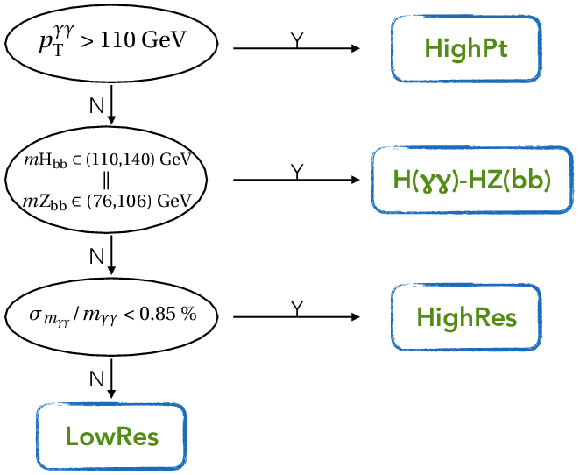
png pdf |
Figure 2:
A flowchart showing the event categorization procedure. |
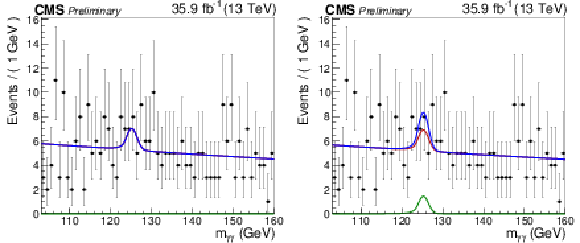
png pdf |
Figure 3:
The diphoton mass distribution for the search region bin with MR> 600 GeV and R2> 0.025 in the HighPt category are shown along with the background-only fit (left) and the signal plus background fit (right). The red curve represents the background prediction; the green curve represents the signal; and the blue curve represents the sum of the signal and background. |

png pdf |
Figure 3-a:
The diphoton mass distribution for the search region bin with MR> 600 GeV and R2> 0.025 in the HighPt category is shown along with the background-only fit. The red curve represents the background prediction; the green curve represents the signal; and the blue curve represents the sum of the signal and background. |
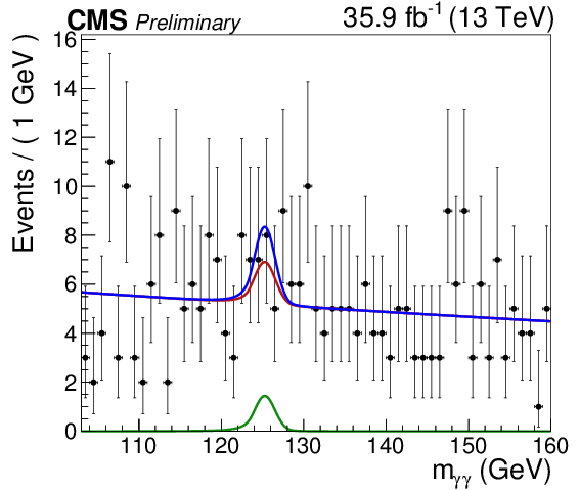
png pdf |
Figure 3-b:
The diphoton mass distribution for the search region bin with MR> 600 GeV and R2> 0.025 in the HighPt category are shown along with the signal plus background fit. The red curve represents the background prediction; the green curve represents the signal; and the blue curve represents the sum of the signal and background. |
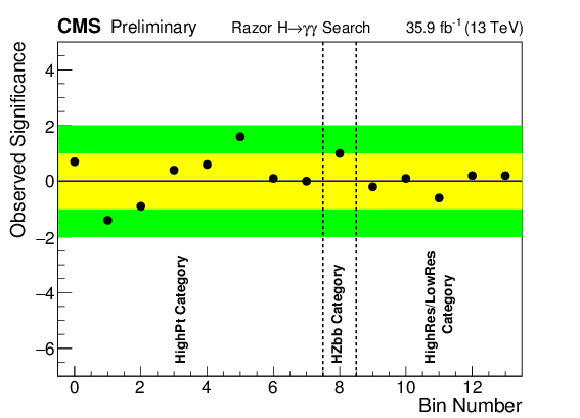
png pdf |
Figure 4:
The observed significance in units of standard deviations is plotted for each search bin. The significance is computed using the profile likelihood, where the sign reflects whether an excess (positive sign) or deficit (negative sign) is observed. The categories that the bins belong to are labeled at the bottom. The yellow and green bands represent the 1σ and 2σ regions, respectively. |
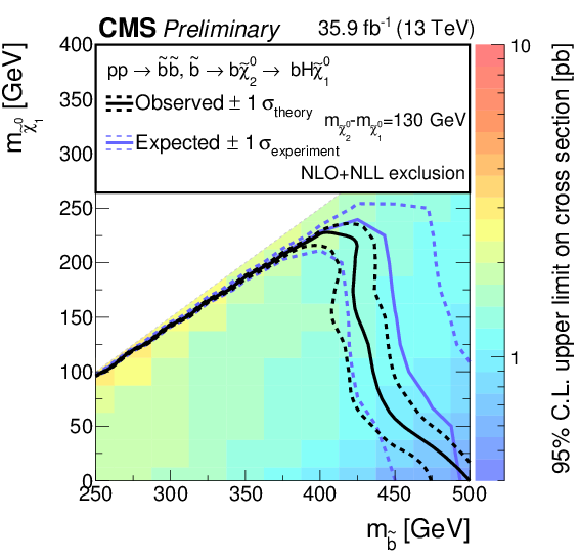
png pdf root |
Figure 5:
The observed 95% confidence level (C.L.) upper limits on the production cross section for bottom squark pair production decaying to a bottom quark, a Higgs boson, and the LSP are shown. The solid and dotted black contours represent the observed exclusion region and its 1σ bands, while the analogous blue contours represent the expected exclusion region and its 1σ bands. |
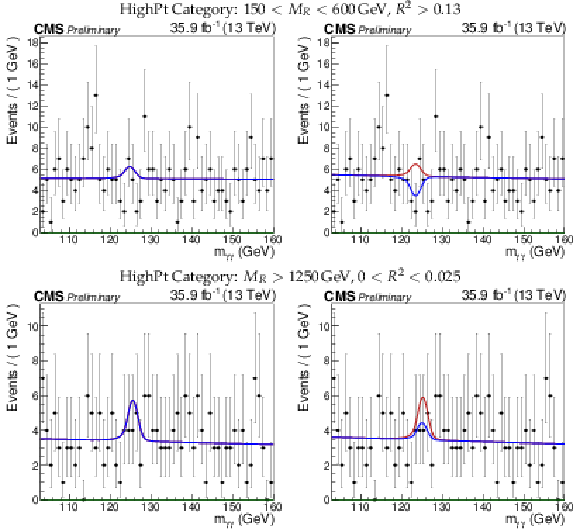
png pdf |
Figure 6:
The diphoton mass distribution for various search region bins in the HighPt category are shown along with the background-only fit (left) and the signal plus background fit (right). The red curve represents the background prediction; the green curve represents the signal; and the blue curve represents the sum of the signal and background. The definition of the bin is labeled above each pair of plots. |
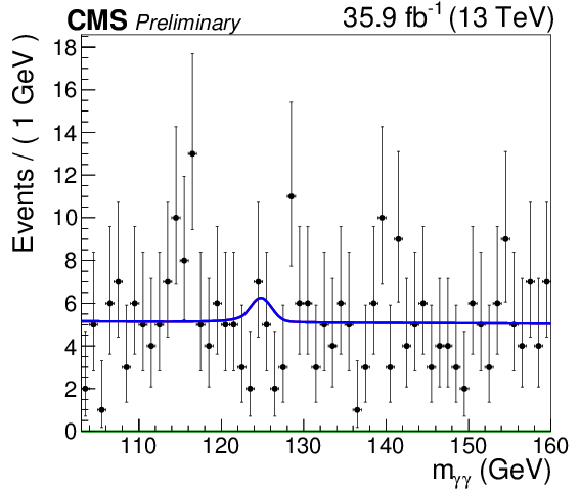
png pdf |
Figure 6-a:
The diphoton mass distribution for search region bin 150 <MR< 600 GeV and R2> 0.13 in the HighPt category is shown along with the background-only fit. The red curve represents the background prediction; the green curve represents the signal; and the blue curve represents the sum of the signal and background. |
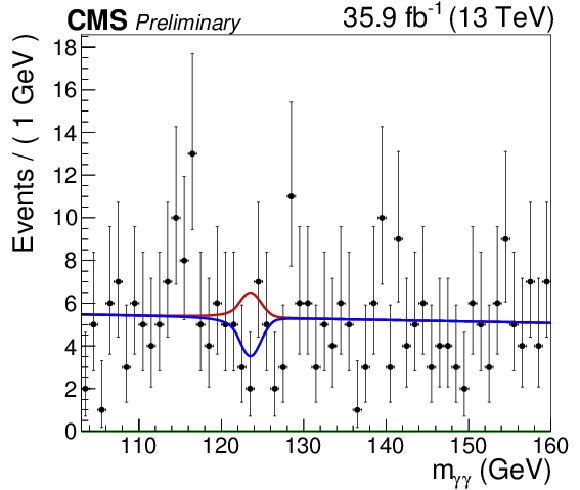
png pdf |
Figure 6-b:
The diphoton mass distribution for search region bin 150 <MR< 600 GeV and R2> 0.13 in the HighPt category is shown along with the signal plus background fit.The red curve represents the background prediction; the green curve represents the signal; and the blue curve represents the sum of the signal and background. |
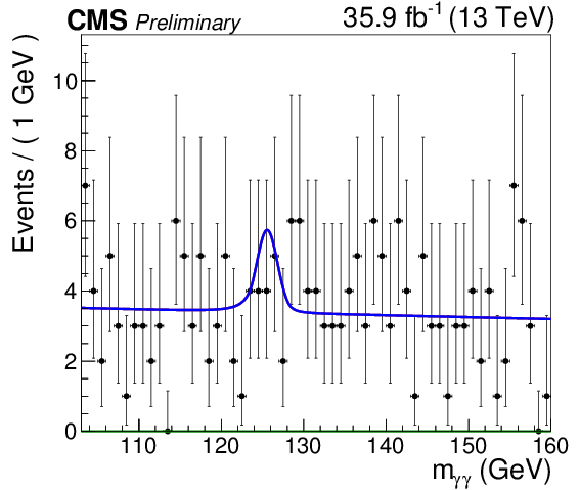
png pdf |
Figure 6-c:
The diphoton mass distribution for search region bin MR> 1250 GeV and 0 <R2< 0.025 in the HighPt category is shown along with the background-only fit. The red curve represents the background prediction; the green curve represents the signal; and the blue curve represents the sum of the signal and background. |
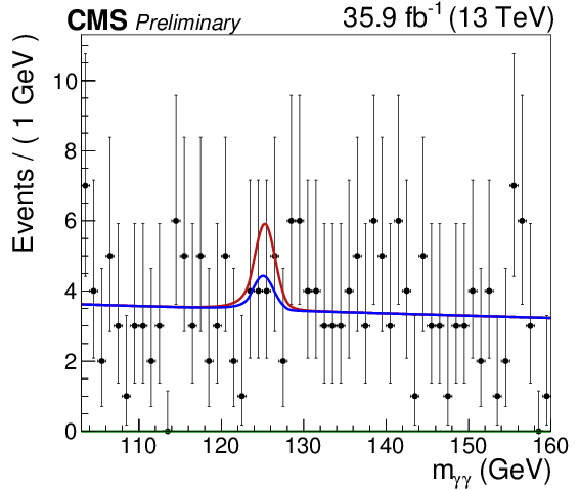
png pdf |
Figure 6-d:
The diphoton mass distribution for search region bin MR> 1250 GeV and 0 <R2< 0.025 in the HighPt category is shown along with the signal plus background fit. The red curve represents the background prediction; the green curve represents the signal; and the blue curve represents the sum of the signal and background. |
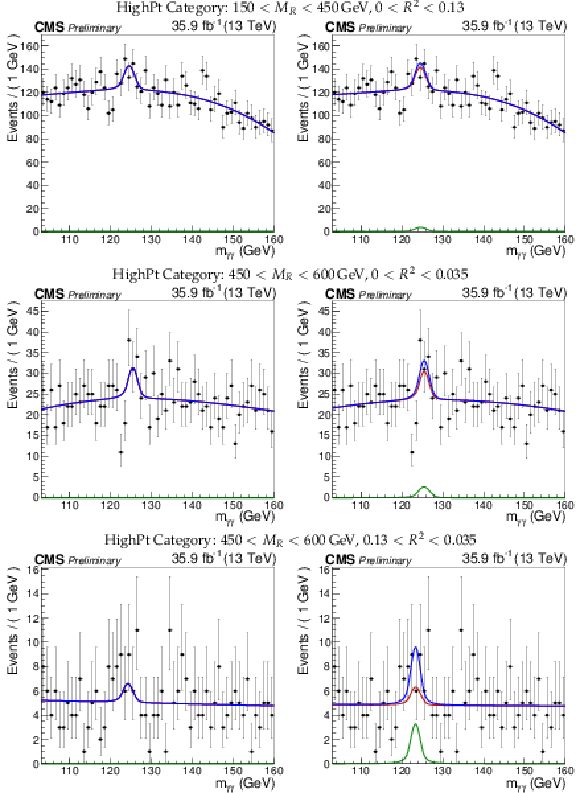
png pdf |
Figure 7:
The diphoton mass distribution for various search region bins in the HighPt category are shown along with the background-only fit (left) and the signal plus background fit (right). The red curve represents the background prediction; the green curve represents the signal; and the blue curve represents the sum of the signal and background. The definition of the bin is labeled above each pair of plots. |
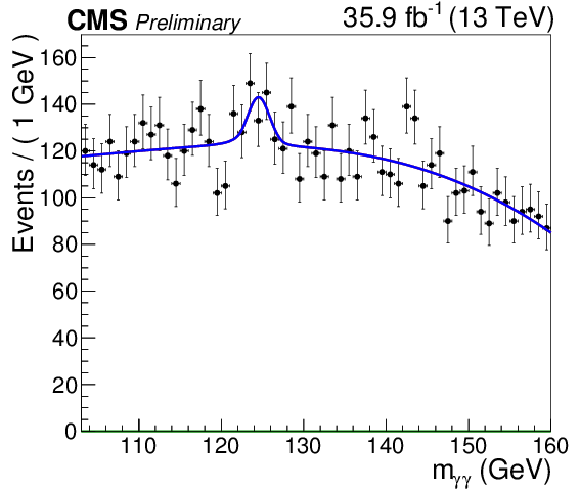
png pdf |
Figure 7-a:
The diphoton mass distribution for search region bin 150 <MR< 450 GeV and 0 <R2< 0.13 in the HighPt category is shown along with the background-only fit. The red curve represents the background prediction; the green curve represents the signal; and the blue curve represents the sum of the signal and background. |
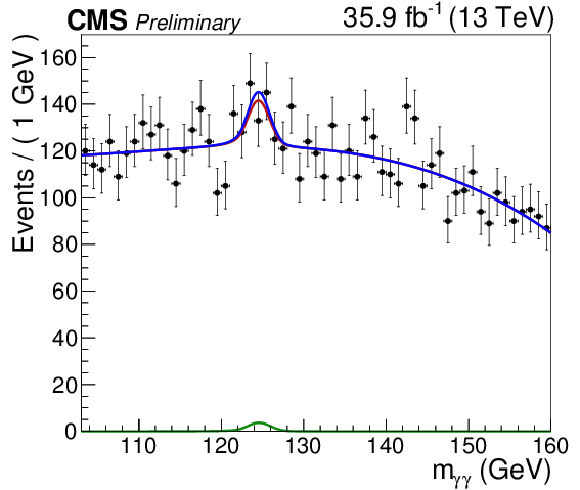
png pdf |
Figure 7-b:
The diphoton mass distribution for search region bin 150 <MR< 450 GeV and 0 <R2< 0.13 in the HighPt category is shown along with the signal plus background fit. The red curve represents the background prediction; the green curve represents the signal; and the blue curve represents the sum of the signal and background. |
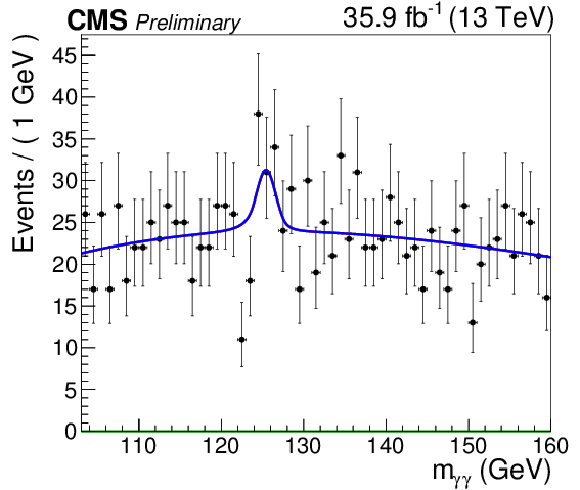
png pdf |
Figure 7-c:
The diphoton mass distribution for search region bin 450 <MR< 600 GeV and 0 <R2< 0.035 in the HighPt category is shown along with the background-only fit. The red curve represents the background prediction; the green curve represents the signal; and the blue curve represents the sum of the signal and background. |

png pdf |
Figure 7-d:
The diphoton mass distribution for search region bin 450 <MR< 600 GeV and 0 <R2< 0.035 in the HighPt category is shown along with the signal plus background fit. The red curve represents the background prediction; the green curve represents the signal; and the blue curve represents the sum of the signal and background. |
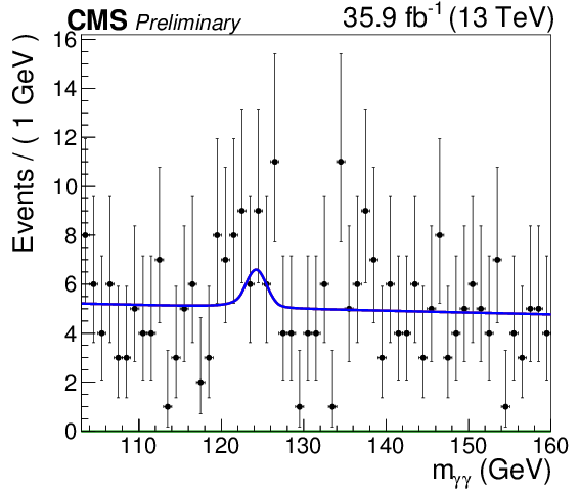
png pdf |
Figure 7-e:
The diphoton mass distribution for search region bin 450 <MR< 600 GeV and 0.035 <R2< 0.13 in the HighPt category is shown along with the background-only fit. The red curve represents the background prediction; the green curve represents the signal; and the blue curve represents the sum of the signal and background. |
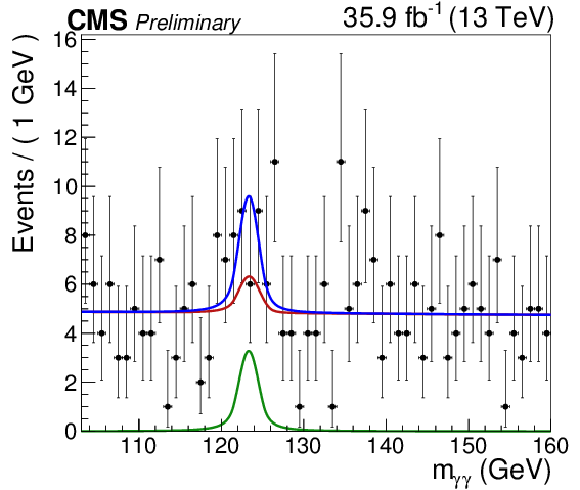
png pdf |
Figure 7-f:
The diphoton mass distribution for search region bin 450 <MR< 600 GeV and 0.035 <R2< 0.13 in the HighPt category is shown along with the signal plus background fit. The red curve represents the background prediction; the green curve represents the signal; and the blue curve represents the sum of the signal and background. |
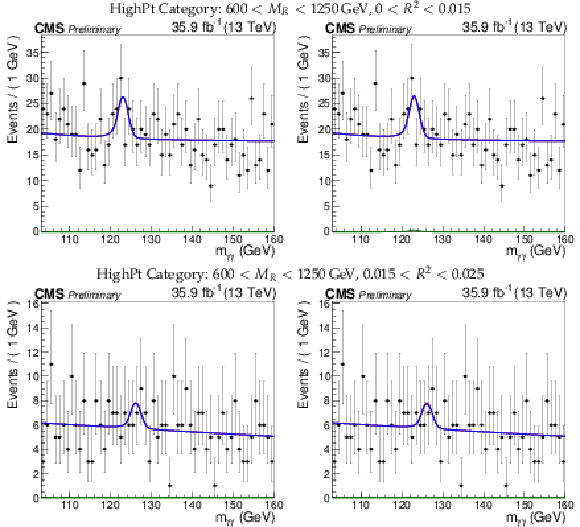
png pdf |
Figure 8:
The diphoton mass distribution for various search region bins in the HighPt category are shown along with the background-only fit (left) and the signal plus background fit (right). The red curve represents the background prediction; the green curve represents the signal; and the blue curve represents the sum of the signal and background. The definition of the bin is labeled above each pair of plots. |

png pdf |
Figure 8-a:
The diphoton mass distribution for search region bin 600 <MR< 1250 GeV and 0 <R2< 0.015 in the HighPt category is shown along with the background-only fit. The red curve represents the background prediction; the green curve represents the signal; and the blue curve represents the sum of the signal and background. |
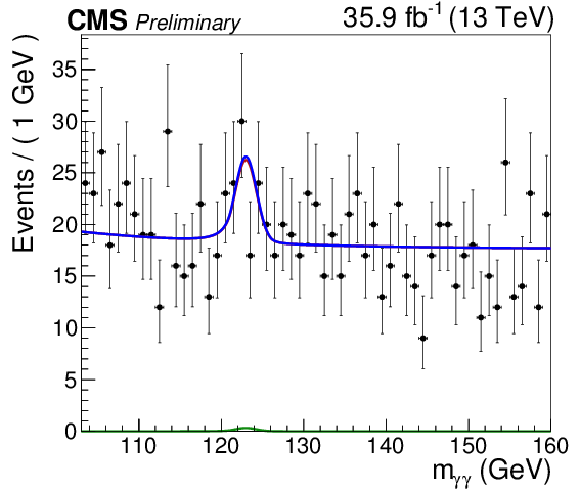
png pdf |
Figure 8-b:
The diphoton mass distribution for search region bin 600 <MR< 1250 GeV and 0 <R2< 0.015 in the HighPt category is shown along with the signal plus background fit. The red curve represents the background prediction; the green curve represents the signal; and the blue curve represents the sum of the signal and background. |

png pdf |
Figure 8-c:
The diphoton mass distribution for search region bin 600 <MR< 1250 GeV and 0 <R2< 0.025 in the HighPt category is shown along with the background-only fit. The red curve represents the background prediction; the green curve represents the signal; and the blue curve represents the sum of the signal and background. |

png pdf |
Figure 8-d:
The diphoton mass distribution for search region bin 600 <MR< 1250 GeV and 0 <R2< 0.025 in the HighPt category is shown along with the signal plus background fit. The red curve represents the background prediction; the green curve represents the signal; and the blue curve represents the sum of the signal and background. |

png pdf |
Figure 9:
The diphoton mass distribution for the search bin MR> 150 GeV in the HZbb category is shown along with the background-only fit (left) and the signal plus background fit (right). The red curve represents the background prediction; the green curve represents the signal; and the blue curve represents the sum of the signal and background. The definition of the bin is labeled above each pair of plots. |
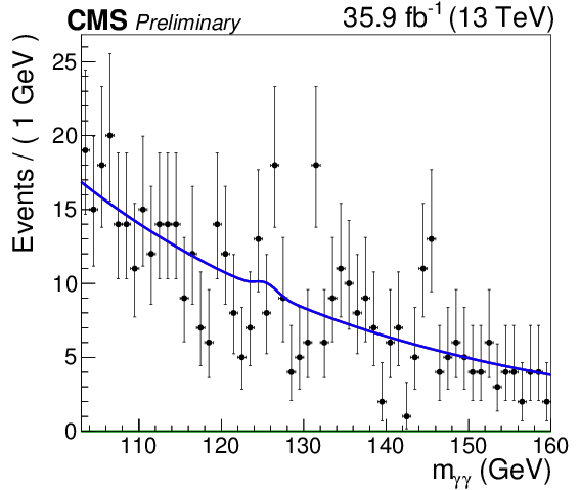
png pdf |
Figure 9-a:
The diphoton mass distribution for search region bin MR< 150 GeV in the HZbb category is shown along with the background-only fit. The red curve represents the background prediction; the green curve represents the signal; and the blue curve represents the sum of the signal and background. |
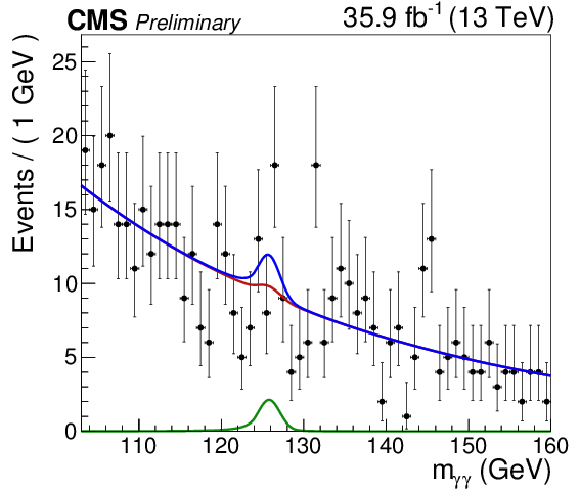
png pdf |
Figure 9-b:
The diphoton mass distribution for search region bin MR< 150 GeV in the HZbb category is shown along with the signal plus background. The red curve represents the background prediction; the green curve represents the signal; and the blue curve represents the sum of the signal and background. |
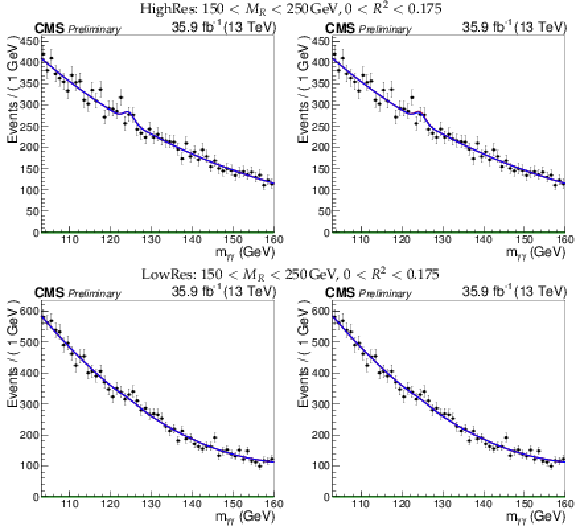
png pdf |
Figure 10:
The diphoton mass distribution for the search region bin 9 are shown along with the background-only fit (left) and the signal plus background fit (right). The top row shows the HighRes category, while the bottom row shows the LowRes category. The red curve represents the background prediction; the green curve represents the signal; and the blue curve represents the sum of the signal and background. The definition of the bin is labeled above each pair of plots. |
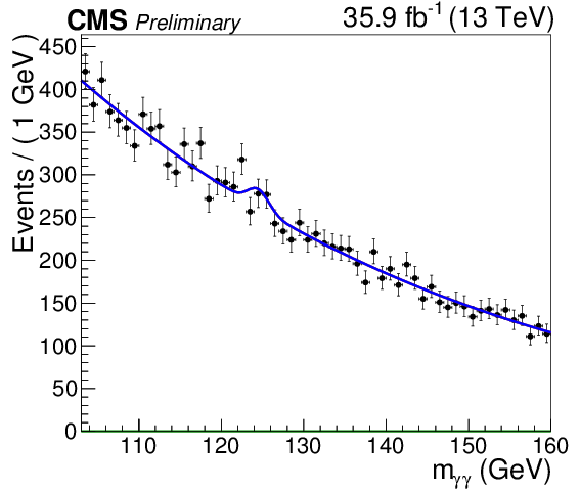
png pdf |
Figure 10-a:
The diphoton mass distribution for the search region bin 9 in the HighRes category is shown along with the background-only fit. The red curve represents the background prediction; the green curve represents the signal; and the blue curve represents the sum of the signal and background. |
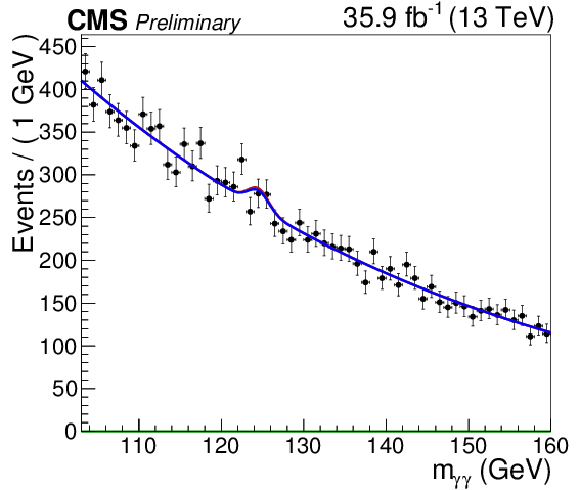
png pdf |
Figure 10-b:
The diphoton mass distribution for the search region bin 9 in the HighRes category is shown along with the signal plus background. The red curve represents the background prediction; the green curve represents the signal; and the blue curve represents the sum of the signal and background. |
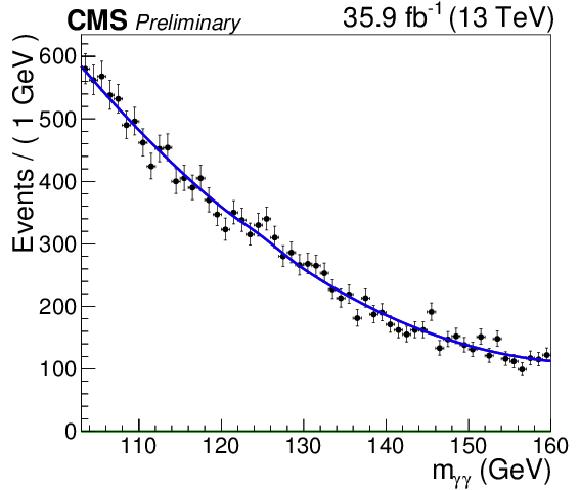
png pdf |
Figure 10-c:
The diphoton mass distribution for the search region bin 9 in the LowRes category is shown along with the background-only fit. The red curve represents the background prediction; the green curve represents the signal; and the blue curve represents the sum of the signal and background. |
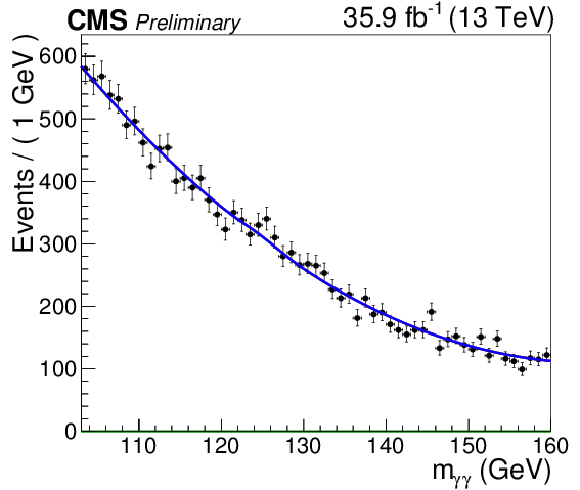
png pdf |
Figure 10-d:
The diphoton mass distribution for the search region bin 9 in the LowRes category is shown along with the signal plus background. The red curve represents the background prediction; the green curve represents the signal; and the blue curve represents the sum of the signal and background. |
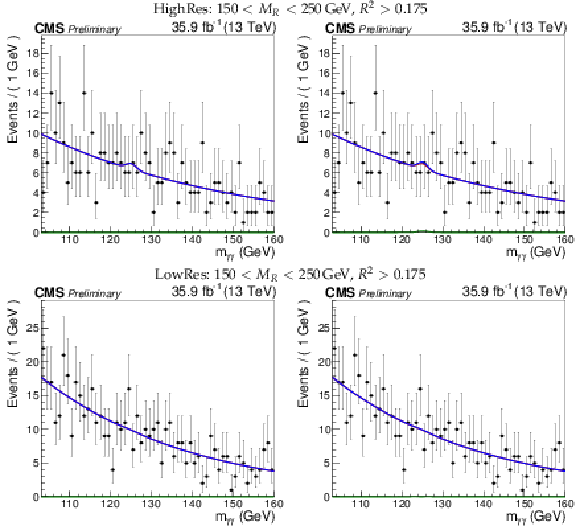
png pdf |
Figure 11:
The diphoton mass distribution for the search region bin 10 are shown along with the background-only fit (left) and the signal plus background fit (right). The top row shows the HighRes category, while the bottom row shows the LowRes category. The red curve represents the background prediction; the green curve represents the signal; and the blue curve represents the sum of the signal and background. The definition of the bin is labeled above each pair of plots. |
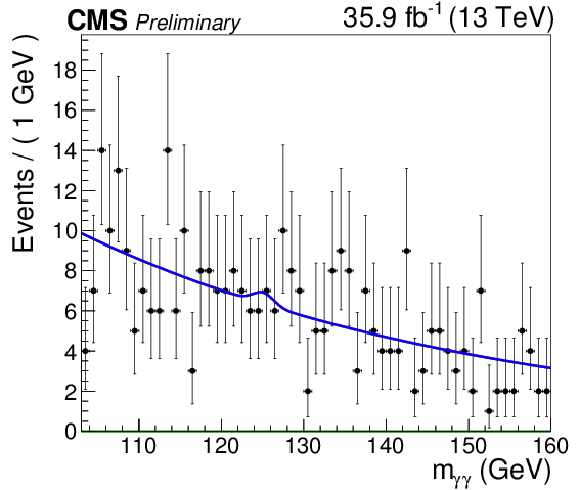
png pdf |
Figure 11-a:
The diphoton mass distribution for the search region bin 10 in the HighRes category is shown along with the background-only fit. The red curve represents the background prediction; the green curve represents the signal; and the blue curve represents the sum of the signal and background. |
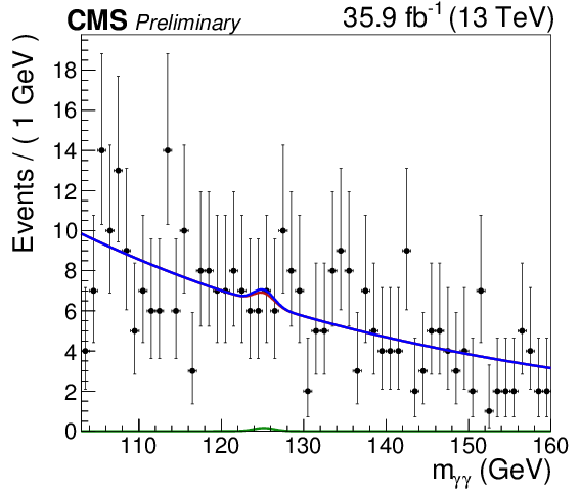
png pdf |
Figure 11-b:
The diphoton mass distribution for the search region bin 10 in the HighRes category is shown along with the signal plus background. The red curve represents the background prediction; the green curve represents the signal; and the blue curve represents the sum of the signal and background. |
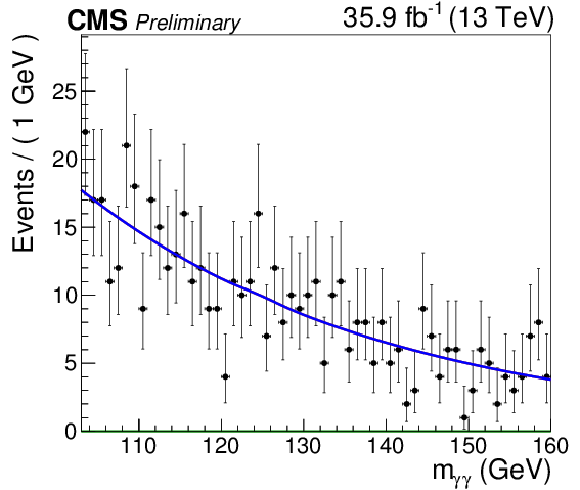
png pdf |
Figure 11-c:
The diphoton mass distribution for the search region bin 10 in the LowRes category is shown along with the background-only fit. The red curve represents the background prediction; the green curve represents the signal; and the blue curve represents the sum of the signal and background. |
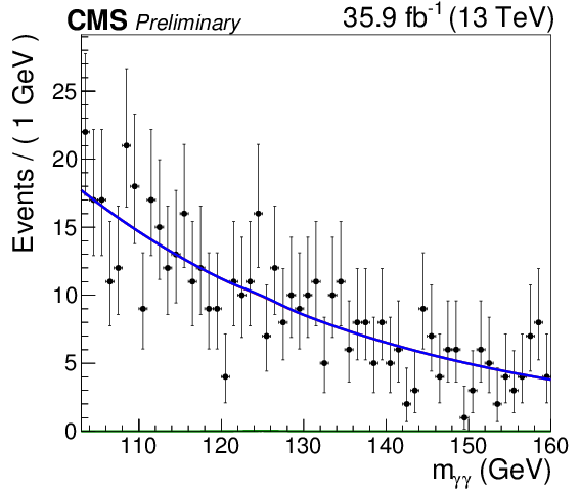
png pdf |
Figure 11-d:
The diphoton mass distribution for the search region bin 10 in the LowRes category is shown along with the signal plus background. The red curve represents the background prediction; the green curve represents the signal; and the blue curve represents the sum of the signal and background. |
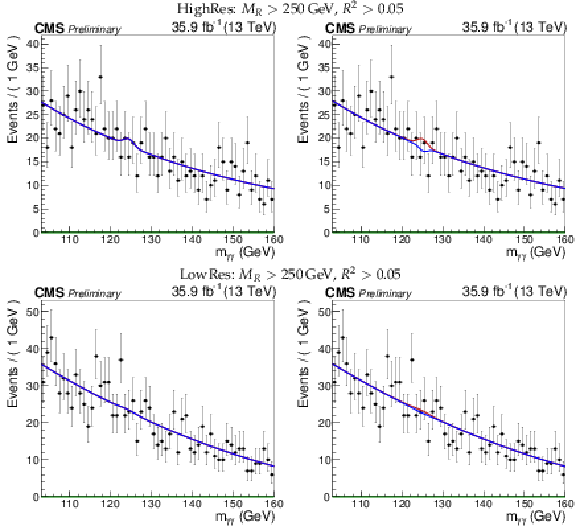
png pdf |
Figure 12:
The diphoton mass distribution for the search region bin 11 are shown along with the background-only fit (left) and the signal plus background fit (right). The top row shows the HighRes category, while the bottom row shows the LowRes category. The red curve represents the background prediction; the green curve represents the signal; and the blue curve represents the sum of the signal and background. The definition of the bin is labeled above each pair of plots. |
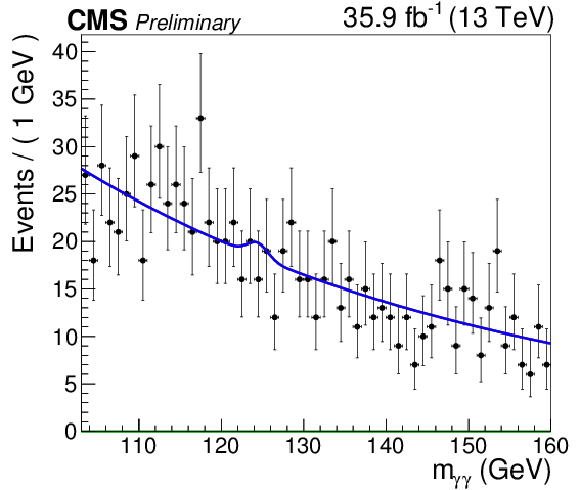
png pdf |
Figure 12-a:
The diphoton mass distribution for the search region bin 11 in the HighRes category is shown along with the background-only fit. The red curve represents the background prediction; the green curve represents the signal; and the blue curve represents the sum of the signal and background. |
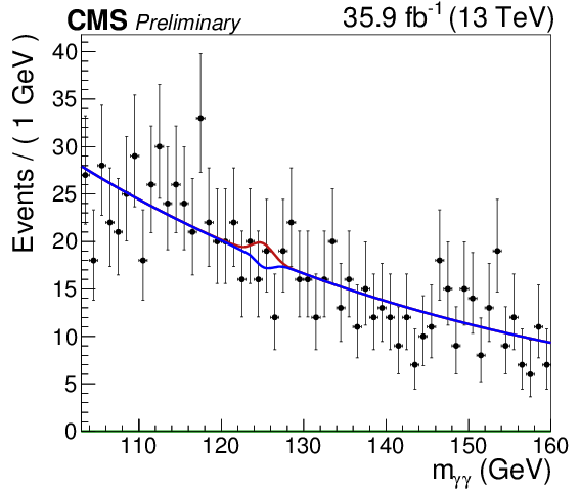
png pdf |
Figure 12-b:
The diphoton mass distribution for the search region bin 11 in the HighRes category is shown along with the signal plus background. The red curve represents the background prediction; the green curve represents the signal; and the blue curve represents the sum of the signal and background. |
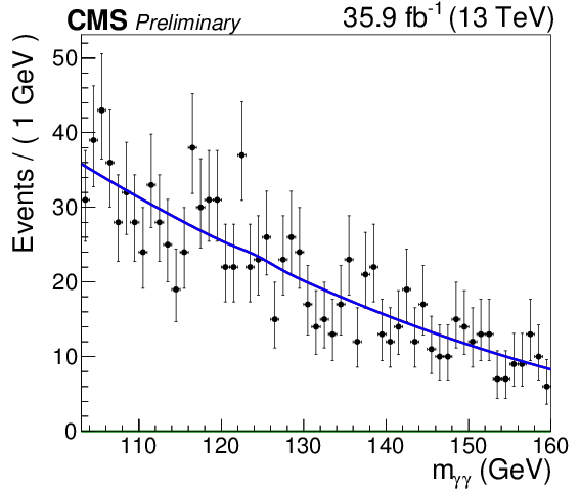
png pdf |
Figure 12-c:
The diphoton mass distribution for the search region bin 11 in the LowRes category is shown along with the background-only fit. The red curve represents the background prediction; the green curve represents the signal; and the blue curve represents the sum of the signal and background. |
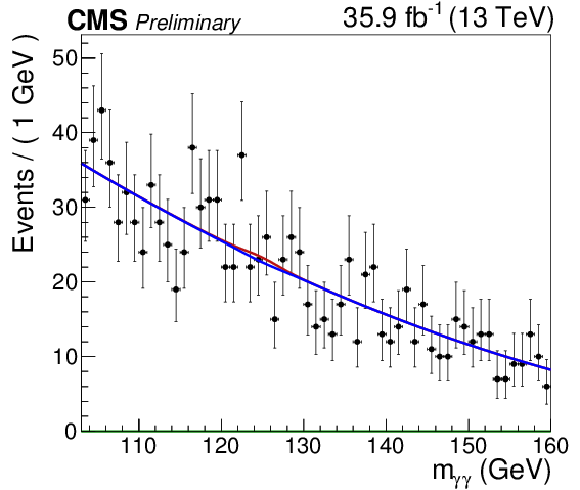
png pdf |
Figure 12-d:
The diphoton mass distribution for the search region bin 11 in the LowRes category is shown along with the signal plus background. The red curve represents the background prediction; the green curve represents the signal; and the blue curve represents the sum of the signal and background. |

png pdf |
Figure 13:
The diphoton mass distribution for the search region bin 12 are shown along with the background-only fit (left) and the signal plus background fit (right). The top row shows the HighRes category, while the bottom row shows the LowRes category. The red curve represents the background prediction; the green curve represents the signal; and the blue curve represents the sum of the signal and background. The definition of the bin is labeled above each pair of plots. |
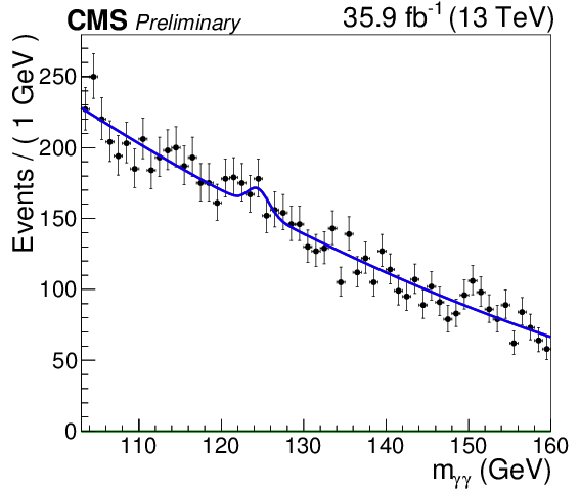
png pdf |
Figure 13-a:
The diphoton mass distribution for the search region bin 12 in the HighRes category is shown along with the background-only fit. The red curve represents the background prediction; the green curve represents the signal; and the blue curve represents the sum of the signal and background. |
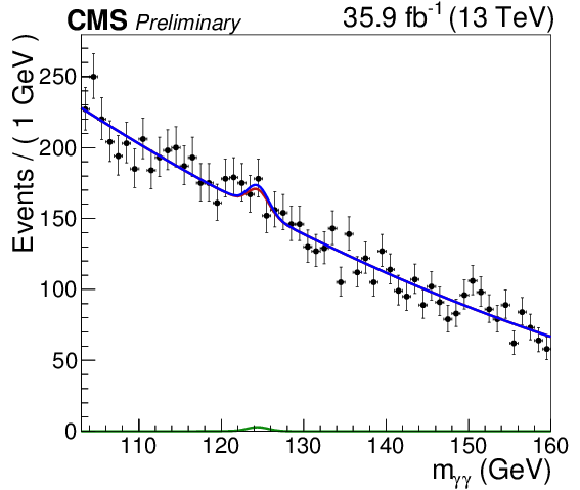
png pdf |
Figure 13-b:
The diphoton mass distribution for the search region bin 12 in the HighRes category is shown along with the signal plus background. The red curve represents the background prediction; the green curve represents the signal; and the blue curve represents the sum of the signal and background. |

png pdf |
Figure 13-c:
The diphoton mass distribution for the search region bin 12 in the LowRes category is shown along with the background-only fit. The red curve represents the background prediction; the green curve represents the signal; and the blue curve represents the sum of the signal and background. |
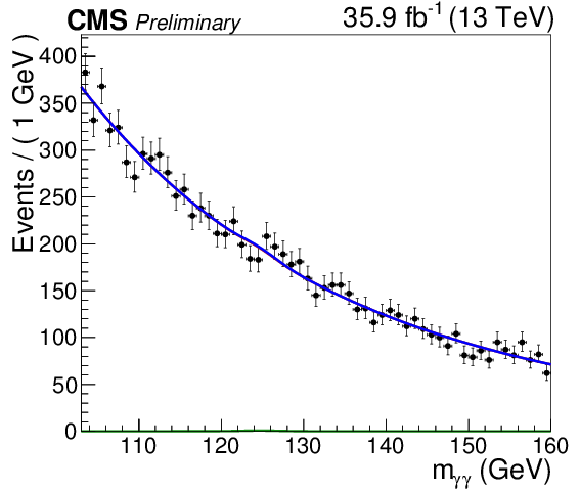
png pdf |
Figure 13-d:
The diphoton mass distribution for the search region bin 12 in the LowRes category is shown along with the signal plus background. The red curve represents the background prediction; the green curve represents the signal; and the blue curve represents the sum of the signal and background. |
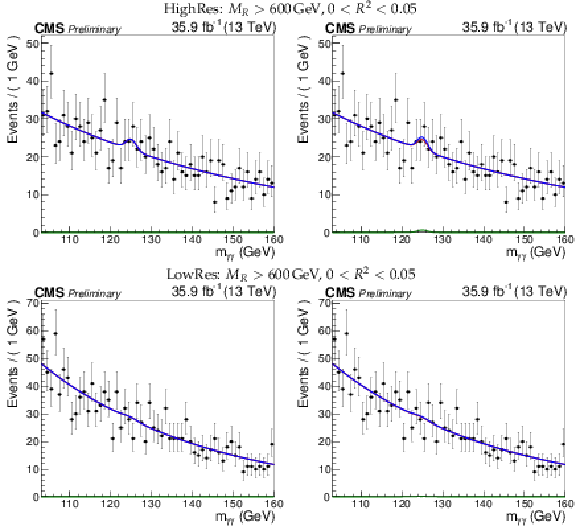
png pdf |
Figure 14:
The diphoton mass distribution for the search region bin 13 are shown along with the background-only fit (left) and the signal plus background fit (right). The top row shows the HighRes category, while the bottom row shows the LowRes category. The red curve represents the background prediction; the green curve represents the signal; and the blue curve represents the sum of the signal and background. The definition of the bin is labeled above each pair of plots. |
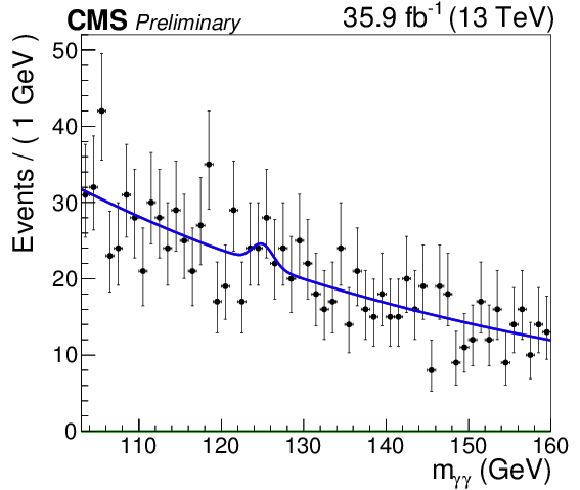
png pdf |
Figure 14-a:
The diphoton mass distribution for the search region bin 13 in the HighRes category is shown along with the background-only fit. The red curve represents the background prediction; the green curve represents the signal; and the blue curve represents the sum of the signal and background. |
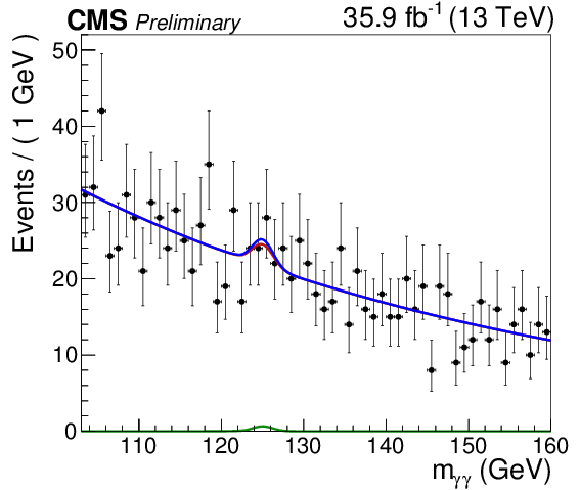
png pdf |
Figure 14-b:
The diphoton mass distribution for the search region bin 13 in the HighRes category is shown along with the signal plus background. The red curve represents the background prediction; the green curve represents the signal; and the blue curve represents the sum of the signal and background. |

png pdf |
Figure 14-c:
The diphoton mass distribution for the search region bin 13 in the LowRes category is shown along with the background-only fit. The red curve represents the background prediction; the green curve represents the signal; and the blue curve represents the sum of the signal and background. |
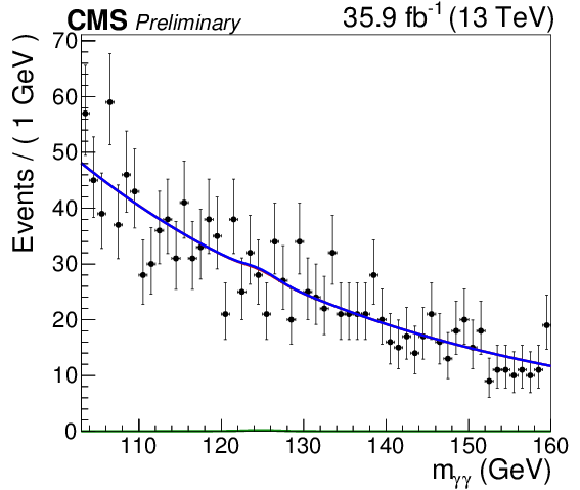
png pdf |
Figure 14-d:
The diphoton mass distribution for the search region bin 13 in the LowRes category is shown along with the signal plus background. The red curve represents the background prediction; the green curve represents the signal; and the blue curve represents the sum of the signal and background. |
| Tables | |

png pdf |
Table 1:
A summary of the search region bins in each category is presented. The functional form used to model the non-resonant background is also listed. An exponential function of the form e−ax is denoted as "single-exp''; a linear combination of two independent exponential functions of the form e−ax and e−bx is denoted as "double-exp''; a modified exponential function of the form e−axb is denoted as "mod-exp''; and a Bernstein polynomial of degree n is denoted by "poly-n''. |
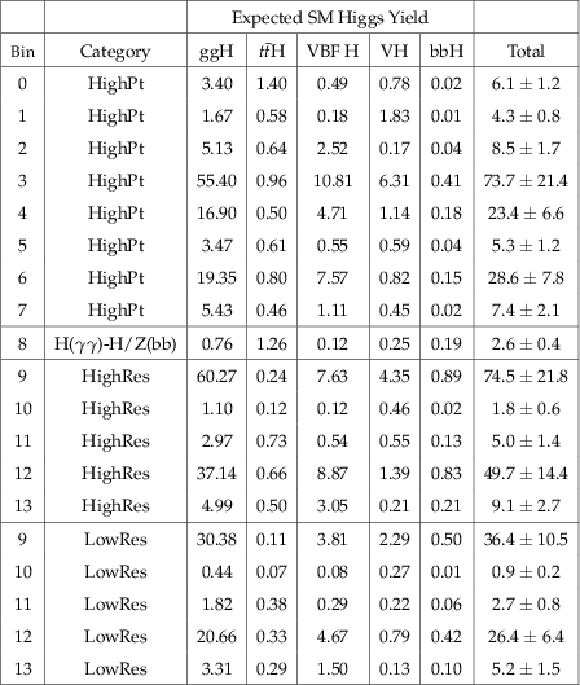
png pdf |
Table 2:
The predicted yields for the SM Higgs background processes are shown for an integrated luminosity corresponding to 36.2 fb−1 for each search region considered in this analysis. The contributions from each SM Higgs process is shown separately, and the total is shown on the rightmost column along with its full uncertainty. |

png pdf |
Table 3:
Summary of systematic uncertainties and their size. |

png pdf |
Table 4:
The non-resonant background yields, fitted SM Higgs background yields, best fit signal yields, and observed local significance are shown for the signal plus background fit in each search region bin. The uncertainties include both statistical and systematic components. The non-resonant background yields shown correspond to the yield within the window between 122 GeV and 129 GeV and are intended to better reflect the background under the signal peak. The observed significance for the bins in HighRes and LowRes categories are identical because they are the result of a simultaneous fit. The significance is computed using the profile likelihood, where the sign reflects whether an excess (positive sign) or deficit (negative sign) is observed. |
| Summary |
| A search for anomalous Higgs boson production through decays of supersymmetric particles is performed with data collected in 2016 by the CMS experiment at the CERN LHC. Proton collisions collected at a center-of-mass energy √s= 13 TeV are considered, corresponding to an integrated luminosity of about 35.9 fb−1. Higgs boson candidates are reconstructed from pairs of photons in the central part of the detector. The razor variables MR and R2 are used to suppress SM Higgs boson production and other SM processes. The non-resonant background is estimated through a data-driven fit to the diphoton mass distribution using a functional form model selected by a combination of the AIC score and the result of a series of bias tests. The SM Higgs background is estimated using the MC simulation, with systematics on instrumental and theoretical uncertainties propagated. We interpret the results in terms of production cross-section limits on bottom squark pair production with each decaying to a Higgs boson, a b-quark, and the LSP, and exclude bottom squarks with mass below 450 GeV for LSP masses below 250 GeV. |
| Additional Figures | |
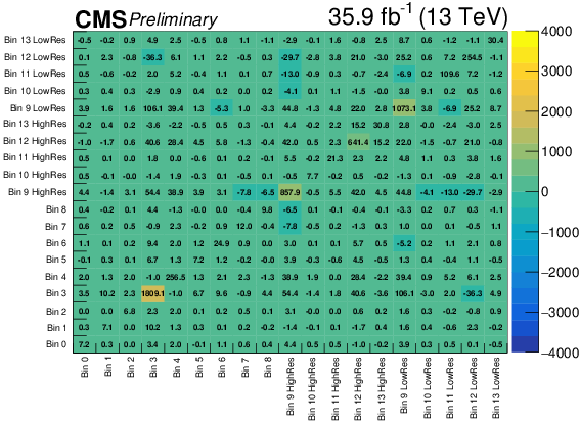
png pdf root |
Additional Figure 1:
The covariance matrix for the background prediction in every search region bin considered in the analysis. |
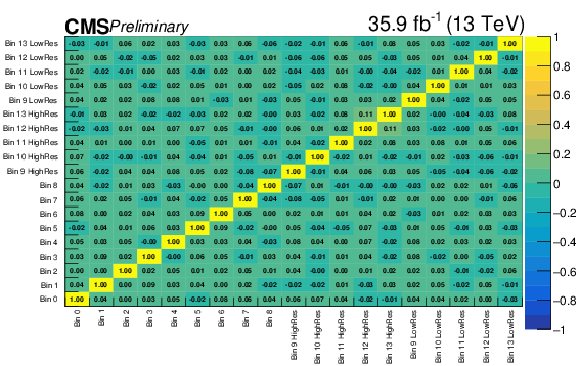
png pdf root |
Additional Figure 2:
The correlation matrix for the background prediction in every search region bin considered in the analysis. |
| Additional Tables | |
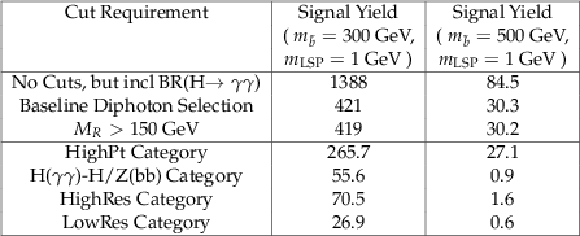
png pdf |
Additional Table 1:
A cut flow table is shown summarizing the expected signal yield for two model points of a simplified model of sbottom pair production in 35.9 fb−1 of integrated luminosity at various stages of the event selection. After the baseline cut of MR> 150 GeV, we show the signal yield distributed into the four exclusive search categories. |
|
Electronic ROOT file versions of the covariance matrix can be found at this link. The covariance matrix is saved as the bin content of a TH2D histogram object.
An example code snippet to compute the variables MR and R2 is provided at this link. Please see the function ComputeRazorVariables which takes as input TLorentzVector objects for the four-momenta of the two photons from the Higgs decay, a vector of TLorentzVector objects of all jets in the event with transverse momentum larger than 30 GeV, and a TLorentzVector for the missing transverse energy. The variables MR and Rsq are computed and passed by reference. |
| References | ||||
| 1 | ATLAS Collaboration | Observation of a new particle in the search for the Standard Model Higgs boson with the ATLAS detector at the LHC | PLB 716 (2012) 1 | 1207.7214 |
| 2 | CMS Collaboration | Observation of a new boson at a mass of 125 GeV with the CMS experiment at the LHC | PLB 716 (2012) 30 | CMS-HIG-12-028 1207.7235 |
| 3 | CMS Collaboration | Observation of a new boson with mass near 125 GeV in pp collisions at √s= 7 and 8 TeV | JHEP 06 (2013) 081 | CMS-HIG-12-036 1303.4571 |
| 4 | CMS Collaboration | Inclusive search for supersymmetry using the razor variables in pp collisions at √s= 7 TeV | PRL 111 (2013) 081802 | CMS-SUS-11-024 1212.6961 |
| 5 | CMS Collaboration | Search for supersymmetry with razor variables in pp collisions at √s= 7 TeV | PRD 90 (2014) 112001 | CMS-SUS-12-005 1405.3961 |
| 6 | CMS Collaboration | The CMS experiment at the CERN LHC | JINST 3 (2008) S08004 | CMS-00-001 |
| 7 | CMS Collaboration | Particle-flow event reconstruction in CMS and performance for jets, taus, and EmissT | CDS | |
| 8 | CMS Collaboration | Commissioning of the particle-flow event with the first LHC collisions recorded in the CMS detector | CDS | |
| 9 | CMS Collaboration | Performance of Photon Reconstruction and Identification with the CMS Detector in Proton-Proton Collisions at sqrt(s) = 8 TeV | JINST 10 (2015), no. 08, P08010 | CMS-EGM-14-001 1502.02702 |
| 10 | M. Cacciari, G. P. Salam, and G. Soyez | FastJet user manual | EPJC 72 (2012) 1896 | 1111.6097 |
| 11 | M. Cacciari, G. P. Salam, and G. Soyez | The anti-kt jet clustering algorithm | JHEP 04 (2008) 063 | 0802.1189 |
| 12 | CMS Collaboration | Identification of b quark jets at the CMS Experiment in the LHC Run 2 | CMS-PAS-JME-14-001 | CMS-PAS-JME-14-001 |
| 13 | CMS Collaboration | Missing transverse energy performance of the CMS detector | JINST 6 (2011) P09001 | CMS-JME-10-009 1106.5048 |
| 14 | CMS Collaboration | Search for New Physics in the Multijet and Missing Transverse Momentum Final State in Proton-Proton Collisions at √s= 7 TeV | PRL 109 (2012) 171803 | CMS-SUS-12-011 1207.1898 |
| 15 | CMS Collaboration | Performance of the CMS missing transverse momentum reconstruction in pp data at √s= 8 TeV | JINST 10 (2015) P02006 | CMS-JME-13-003 1411.0511 |
| 16 | J. Alwall et al. | The automated computation of tree-level and next-to-leading order differential cross sections, and their matching to parton shower simulations | JHEP 07 (2014) 079 | 1405.0301 |
| 17 | T. Sjostrand, S. Mrenna, and P. Skands | A brief introduction to PYTHIA 8.1 | Comp. Phys. Commun. 178 (2008) 852 | |
| 18 | NNPDF Collaboration | Parton distributions for the LHC Run II | JHEP 04 (2015) 040 | 1410.8849 |
| 19 | GEANT4 Collaboration | GEANT4---a simulation toolkit | NIMA 506 (2003) 250 | |
| 20 | CMS Collaboration | The fast simulation of the CMS detector at LHC | J. Phys.: Conf. Ser. 331 (2011) 032049 | |
| 21 | LHC Higgs Cross Section Working Group Collaboration | Handbook of LHC Higgs Cross Sections: 4. Deciphering the Nature of the Higgs Sector | 1610.07922 | |
| 22 | W. Beenakker, R. Hopker, M. Spira, and P. M. Zerwas | Squark and gluino production at hadron colliders | Nucl. Phys. B 492 (1997) 51 | hep-ph/9610490 |
| 23 | A. Kulesza and L. Motyka | Threshold resummation for squark-antisquark and gluino-pair production at the LHC | PRL 102 (2009) 111802 | 0807.2405 |
| 24 | A. Kulesza and L. Motyka | Soft gluon resummation for the production of gluino-gluino and squark-antisquark pairs at the LHC | PRD 80 (2009) 095004 | 0905.4749 |
| 25 | W. Beenakker et al. | Soft-gluon resummation for squark and gluino hadroproduction | JHEP 12 (2009) 041 | 0909.4418 |
| 26 | W. Beenakker et al. | Squark and gluino hadroproduction | Int. J. Mod. Phys. A 26 (2011) 2637 | 1105.1110 |
| 27 | C. Borschensky et al. | Squark and gluino production cross sections in pp collisions at √s= 13, 14, 33 and 100 TeV | EPJC 74 (2014) 3174 | 1407.5066 |
| 28 | H. Akaike | A new look at the statistical model identification | IEEE Transactions on Automatic Control 19-6 (1974) 716--723 | |
| 29 | M. Oreglia | PhD thesis, SLAC | ||
| 30 | J. Gaiser | PhD thesis, SLAC | ||
| 31 | ATLAS and CMS Collaborations | Procedure for the LHC Higgs boson search combination in summer 2011 | CMS-NOTE-2011-005 | |

|
Compact Muon Solenoid LHC, CERN |

|

|

|

|

|

|